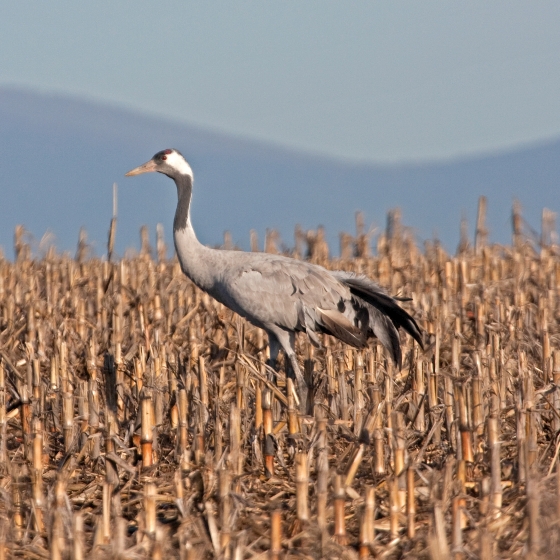Crane

Introduction
An unmistakable species, recorded as extinct in UK in the 18th century but returned to the UK in the 1980s.
In the modern era Cranes were first recorded breeding in Norfolk in 1981 and their population has increased fast with at least 30 pairs now breeding regularly, and an increasing group in Somerset following a reintroduction scheme.
In winter the species has started to form large flocks, particularly in the Nene and Ouse Washes in the Fens, and in the Broads of north-west Norfolk. Sightings of 50 birds together are now possible and the sound of loud bugling calls, echoing across the flatlands, will not be forgotten.

Key Stats
Identification
Songs and Calls
Call:
Status and Trends
Conservation Status
Population Change
Cranes formerly bred in the UK but became extinct in the sixteenth century (Stanbury et al. 2011). A small Crane population has persisted in Norfolk since the 1980s (Stanbury et al 2011) with both numbers and the UK breeding range increasing more strongly in the 21st century to a five-year mean of 40 breeding pairs over the period 2015–2019 (Eaton et al. 2021). Cranes now breed widely across the UK including, from 2012, in Scotland (Biggins & Maggs 2021) and numbers have also been boosted by releases between 2010 and 2014 (Eaton et al. 2021).
Distribution
Cranes have increased significantly over the last few decades. During Bird Atlas 2007–11 breeding evidence was received for 21 10-km squares, most falling in four extensive areas of relatively undisturbed wetlands in Britain. In 2011 the winteirng population was estimated at c.50 birds with the majority in southern England, particularly the Broads and Fens. By the 2020s that number may be 2–3 times higher.
Occupied 10-km squares in UK
or view it on Bird Atlas Mapstore.
or view it on Bird Atlas Mapstore.
European Distribution Map
Distribution Change
Change in occupied 10-km squares in the UK
or view it on Bird Atlas Mapstore.
or view it on Bird Atlas Mapstore.
Seasonality
Cranes are localised but can be encountered throughout the year.
Weekly pattern of occurrence
The graph shows when the species is present in the UK, with taller bars indicating a higher likelihood of encountering the species in appropriate regions and habitats.

Movement
Britain & Ireland movement
Foreign locations of birds ringed or recovered in Britain & Ireland
Dots show the foreign destinations of birds ringed in Britain & Ireland, and the origins of birds ringed overseas that were subsequently recaptured, resighted or found dead in Britain & Ireland. Dot colours indicate the time of year that the species was present at the location.
- Winter (Nov-Feb)
- Spring (Mar-Apr)
- Summer (May-Jul)
- Autumn (Aug-Oct)

European movements
EuroBirdPortal uses birdwatcher's records, such as those logged in BirdTrack to map the flows of birds as they arrive and depart Europe. See maps for this species here.
The Eurasian-African Migration Atlas shows movements of individual birds ringed or recovered in Europe. See maps for this species here.
Biology
Productivity and Nesting
Nesting timing
Egg measurements
Clutch Size
Survival and Longevity
Survival is shown as the proportion of birds surviving from one year to the next and is derived from bird ringing data. It can also be used to estimate how long birds typically live.
View number ringed each year in the Online Ringing Report.
lifespan
Survival of adults
Survival of juveniles
Classification, names and codes
Classification and Codes
- Order: Gruiformes
- Family: Gruidae
- Scientific name: Grus grus
- Authority: Linnaeus, 1758
- BTO 2-letter code: AN
- BTO 5-letter code: CRANE
- Euring code number: 4330
Alternate species names
- Catalan: grua europea
- Czech: jeráb popelavý
- Danish: Trane
- Dutch: Kraanvogel
- Estonian: sookurg
- Finnish: kurki
- French: Grue cendrée
- Gaelic: Corra-mhonaidh
- German: Kranich
- Hungarian: daru
- Icelandic: Grátrana
- Irish: Grús
- Italian: Gru
- Latvian: (peleka) dzerve
- Lithuanian: pilkoji gerve
- Norwegian: Trane
- Polish: zuraw (zwyczajny)
- Portuguese: grou
- Slovak: žeriav popolavý
- Slovenian: žerjav
- Spanish: Grulla común
- Swedish: trana
- Welsh: Garan
Research
Causes of Change and Solutions
Causes of change
The growth of the Crane population since recolonisation has been slow, with low productivity in the initial population in the Broads. It is not clear whether the recent range expansion has originated from the Broads or from new immigrants from Europe, though it has also been assisted by reintroductions (Stanbury et al. 2011). Cranes require large areas of undisturbed wetland to breed and further expansion may be limited by habitat availability (Stanbury et al. 2011).

